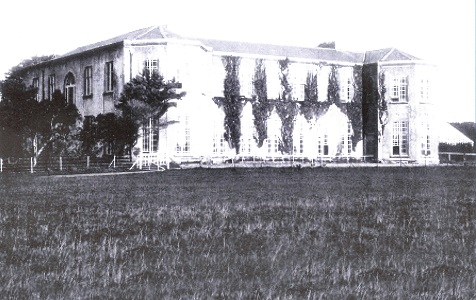Merlin Park House

by Tom Kenny
The Blake family started work on the construction of Merlin Park House in 1808 and it was completed in 1812. It cost £12,000 to build and provided much needed employment for many local skilled workers and labourers. Getting materials to the location proved difficult – it was said that more than 40 mules were used to transport goods and building materials from Galway to the site.
The house was described as “A long two storey house consisting of six bays and two 3-sided bows” standing on 1,109 acres, three roods, and eight perches. The estate consisted of 224 acres of arable land, five acres of roads and drives, four acres of gardens and orchards, all surrounded by a wall over 15 feet high, and more than 100 acres under plantation.
On completion of the house, it became a go-to venue for lavish parties and balls attended by the gentry and landed families. Partying, hunting, and shooting became the order of the day. It was said that during a prolonged party which lasted three days and nights, a maid servant named Mary McManus fell to her death over a banister which overlooked the basement. Rather than interrupt the festivities, she was buried in haste close to where she was found. The house was said to have a resident ghost, a spectral form of a white lady who wandered the corridors — the spirit of Mary McManus perhaps!
The Blake family never used their land for any commercial purpose except for the productive horticultural garden which provided them with fruit and vegetables. They eventually lost the estate and the Encumbered Estates sold it to a Mr Hodgson for £8,000 in 1852. “The mansion is a spacious and commodious residence. The reception and bedrooms are unusually large and lofty with a noble staircase all in order and repair.” Hodgson lived there until 1876 when the house and lands were sold to Robert Waithman, a magistrate. In 1887, he and his wife had a son, Wyndham, who had a distinguished military career in World War I. He played an active role in the commercial life of Galway – he was involved in setting up Galway Foundry and of the dairy in Renmore, he redeveloped the marble quarry on his estate and he was instrumental in the revival of Galway Sailing Club. His first wife died in 1933 and he married Eileen O’Driscoll in 1942 and with her he became involved in a lot of charity work.
They were approached by the Government in 1945 who wanted to purchase the land to build a sanatorium in order to fight against the highly prevalent disease TB. The Waithmans were naturally upset but then Wyndham said: “If it saves one life, who are we to object?” They moved to Murrough House, a more modest residence that stood on the south of the estate. They lived there until Wyndham died in 1975, and then Mrs Waithman moved to a cottage in the grounds of Merlin Park. It was essential that the battle against the TB epidemic was approached from a ‘green field site’ so Merlin Park House was demolished.
All of this information and much more is contained in a new book entitled A Georgian Memory, A Brief History of Merlin Park House & Estate written and published by Norbert Sheerin. It is well illustrated and is a valuable addition to every Galwegian’s library. In good bookshops at only €10.
